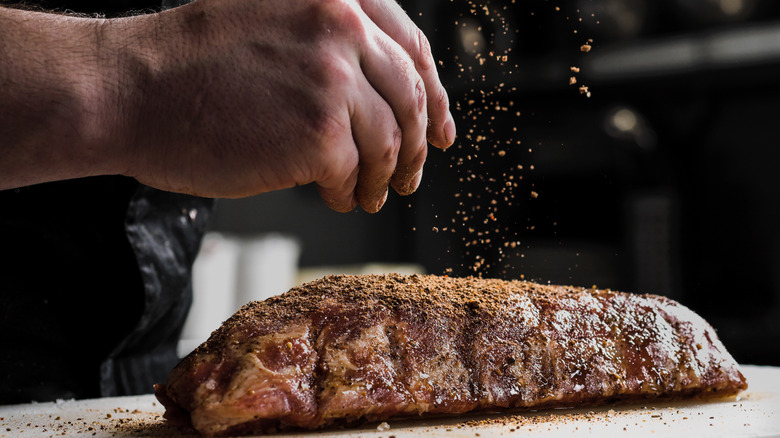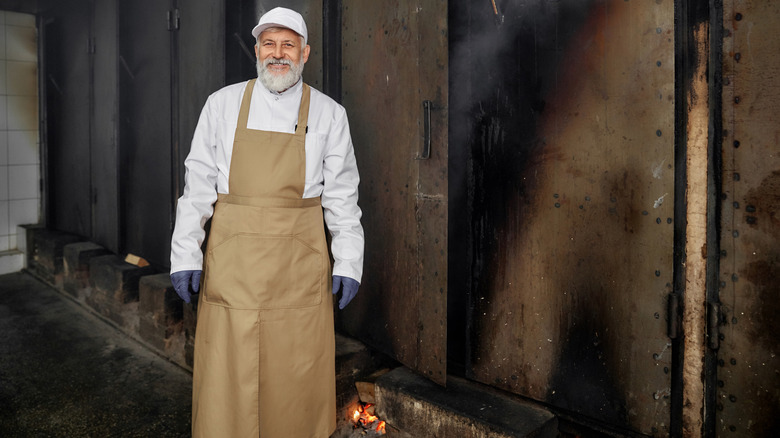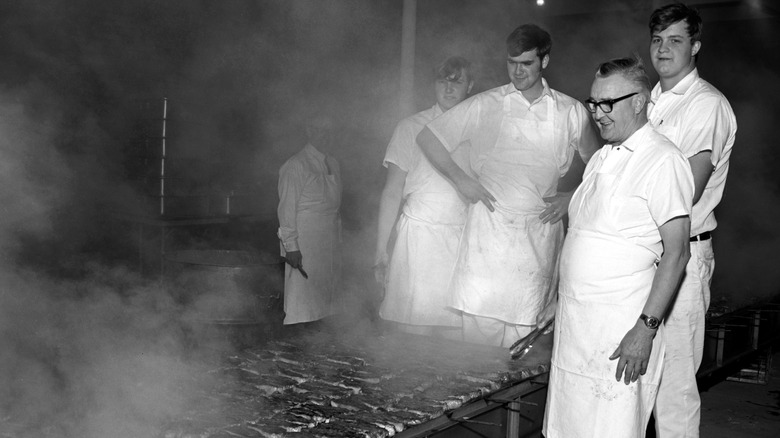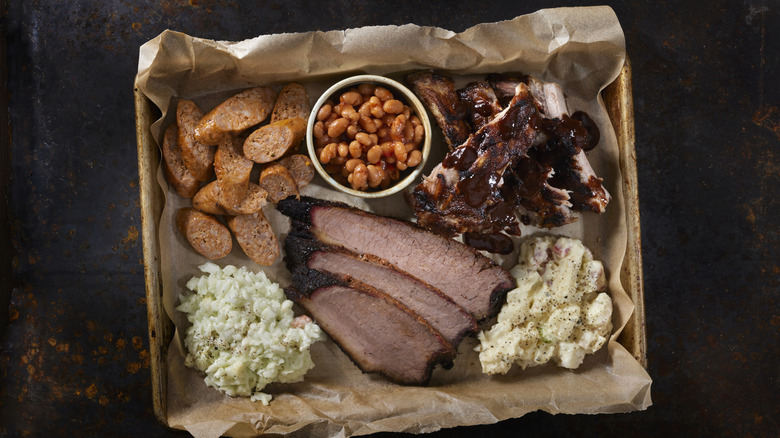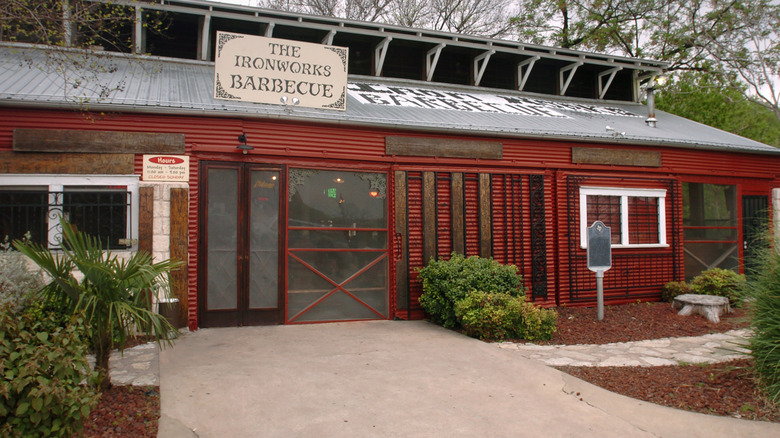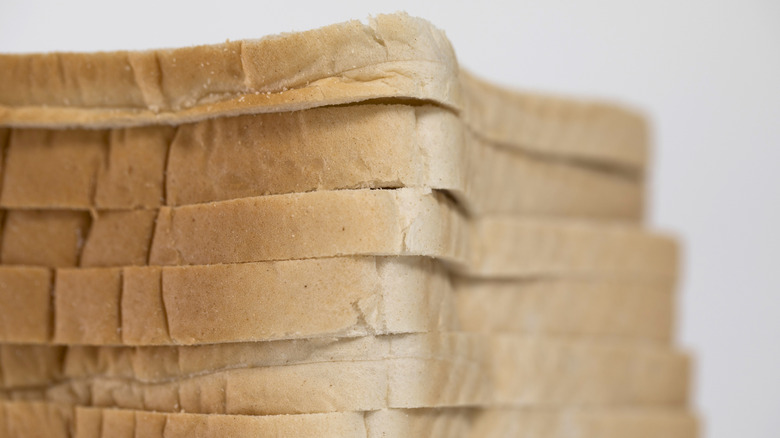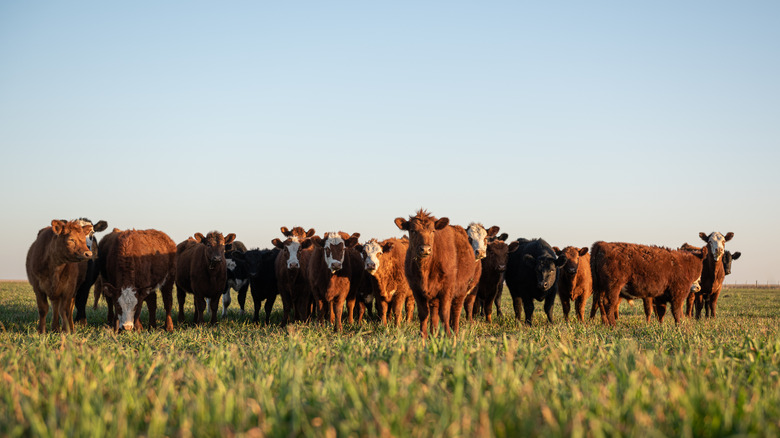Signs You Are In A Bad Barbecue Restaurant
For many American eaters, barbecue is a serious subject. An ancient form of cooking that has since evolved into a national cuisine, barbecue predilections often reflect who a person is, where they grew up, and what they value in a dining experience. On the other hand, bad barbecue eateries don't celebrate this identity or embrace the time, commitment, and effort it takes to uphold this culinary tradition. So why would anyone chose to eat at a less-than-stellar barbecue joint? Well, they probably wouldn't. However, many diners might not know the signs of an underwhelming barbecue restaurant upon first glance. Get your appetite ready and break out the napkins, because here are the 12 signs any smoked meat enjoyer should look for when choosing a good barbecue joint over a bad one.
See if a pitmaster runs the show
The author matters. The director matters. The painter matters. There's a reason the film is called "The Wizard of Oz," and not "Dorothy of Oz". We want to know who's behind the curtain, because that dictates what's in front of the curtain. When it comes time to decide whether to patronize a barbecue establishment or run from it screaming, see if you can learn more about the pitmaster(s) behind the scenes. This can usually be accomplished by visiting the restaurant's website, conversing with customers in the community, or just asking the staff.
Many great barbecue joints have a reputable pitmaster at the helm, and will usually tout their CV: how many awards or competitions they've won, the years of experience, or perhaps the exact thousands of briskets they've smoked. However, a pitmaster's stamp goes beyond prowess in smoked meats. Values, attitude, philosophy, and a love for one of civilization's oldest cooking methods all reflect in overall customer appreciation and restaurant performance. A barbecue eatery without any pitmaster is a sign that it may lack direction, cohesion, and pride for the food it puts out. No master often means no mastery. That may be acceptable other types of restaurants, but not a smokehouse.
No smoke and no fire means no authenticity
Barbecuing isn't grilling. In fact, they are almost entirely opposite methods of cooking. You can grill to your heart's desire in a backyard or commandeered park, but that's not why diners go to a barbecue restaurant. Those succulent servings of brisket, ribs, pork butt, et al. require smoke pits for proper finishing (along with time and a little blue-collar finesse). Therefore, look for a smoker on site when choosing a barbecue place. A lot of locations will keep these visible to customers as a way of showing that everything is handled on site. If you don't see an actual pit, look for the signs. There'll either be smoke wafting through the air from some unseen source to fill your nose (and eyes), or piles of wood for said smoker.
Purported barbecue restaurants with no trace of a smoker (or are in locales that don't allow enough space for it) raise questions about where and how the product is prepared. Which in turn begets another question: Why am I eating here?
The barbecue meat is pre-sauced
The use of sauce in barbecue can be hugely controversial, with no shortage of opinions on the matter. Though barbecue sauce can be easily made at home, the issue has divided states, regions, peoples, and drawls for decades. Not only do BBQ strongholds like Kansas City and North Carolina have their own intra-sauce battles, but many Texans religiously believe that sauce belongs nowhere near the meat at all. Although the latter — like most generalizations — has since been categorized as a misconception, there's one approach to sauce that no real barbecue aficionado approves of: pre-saucing the meat.
At the root of this beef with sauce (intention of pun pending) is trust. A barbecue restaurant known to slather their meat before serving invites suspicion that it's hiding something about the product — perhaps that the meat can't stand on its own as a quality offering. Whether pro-sauce or not, its agreed by many that serving sauce on the side of barbecue is perfectly okay; leaving the choice with the customer. Removing that independence and saucing the meat by default is often a sure sign of paranoid preparation.
There are no paper towels on the table
No frills, no unrendered fat, and no cloth napkins. These are just a few of the unwritten "no's" of authentic retail barbecue. When digging into juicy chunks of meat, do you really want a piece of fabric or translucent pizzeria napkins to wipe down with? A great barbecue joint knows the eating experience is messy, and it knows its customers aren't pretending they're dining at Eleven Madison Park. Food is the focal point of barbecuing, and everything else — the seating, the ambience, the tableware — is purely functional, and in service to the bite. Enter the humble paper towel.
More than a no-nonsense de-soiling utility, sturdy paper towels are a symbol of a barbecue restaurant's ethos. They're one of the most reassuring signs for a customer trying to get their smoked meat on. A peek into a barbecue place's dining area should provide quick clarity regarding the tier of that particular smokehouse. If there's something other than paper towel rolls on the tables, you might want to paleo-indulge elsewhere.
The barbecue joint's menu is all over the place
A good rule of thumb is that restaurants with too many items on the menu don't do any of them well. This is especially true for barbecue, where the strongest operations often have laser-focused menus. This isn't just a philosophical preference — it also comes down to smoking equipment and cooking methods. Sure, there's a lot of room for expression within any particular barbecue style. However, crossing regional barbecue styles is seen as fundamentally flawed; not innovative. Diversity in life: good. Diversity on a barbecue menu: eh ...
This extends to the sauces as well. Real-deal BBQ joints will take time to make their sauces in-house, allowing them a unique spin on classic flavors. Too many sauce options could mean they're just serving wholesale products, or not putting in the effort to perfect their offerings. The customer will lose out either way, and their money is probably better spent elsewhere.
The restaurant doesn't focus on traditional barbecue dishes
Experimentation can be a good thing — at least when it comes to music, science, or the films of Luis Buñuel. But if a restaurant's experimentation comes at the cost of serving classic barbecue dishes, the smokehouse might have to reconsider its approach ... and customers might have to reconsider their choice of eatery.
The reason many authentic barbecue restaurants serve the same meats lies in the origin of modern BBQ. Working people were left with the toughest cuts, and had to learn the time-tested alchemy of smoke to transform these materials into tastebud gold. Offering Wagyu is a barbecue red flag, along with sirloin, burgers, hot dogs, and other foods better suited to grilling. These can be a sign that a smokehouse either doesn't really know what it's doing, doesn't care, or is misguidedly pandering to a wider customer base. Ironically, this can alienate true-blue barbecue lovers — and who wants to do that?
The location doesn't have enough space to operate
This isn't about the state or municipality in which you're hunting for barbecue. No; we're talking about the actual, physical placement of a barbecue restaurant. Smokehouses — unlike other types of eateries – require a certain degree and type of space to properly operate. Not just for the fire, but the giant duct or vent which releases the smoke. Whether restricted by zoning laws or the limits of architecture, a proper setup can't be located just anywhere.
A barbecue joint in the middle of a shopping mall, airport, or any other location not conducive to constant, billowing smoke might not be much of a barbecue place at all. What they're actually doing to the meat is braising, boiling, or using liquid smoke to replace genuine barbecue techniques (heaven help us). If there's one lesson which rings true, it's that there's no shortcuts in legit barbecue. Any eatery avoiding the sacred processes of "low and slow" — either by choice or structural circumstance — might be one to avoid when craving proper barbecue.
There are no lines for the barbecue
When a smokehouse doesn't have a queue for Q — especially during peak meat-eating hours — that's a warning sign which reads "this ain't the place." Given the deliberate nature of great barbecue cooking and the small staff sizes at many a great BBQ shack, waiting is inevitable and even welcomed. Just like the pitmasters themselves, devoted barbecue fans can be extremely patient. So how should customers view a barbecue business devoid of lines, and lacking that palpable devotion? Answer: with a suspiciously raised eyebrow.
Since it looks great for a business to have lines out the door, some folks posit that barbecue places are purposely slow to make lines bigger. That may be a bit cynical, but customer lines are the easiest and quickest visual indicator of a sought-after product (or a tourist trap, if one isn't careful). Time is valuable, so seeing folks spend it standing and waiting for a certain food is very telling. Also very telling? A sparsely populated barbecue restaurant on a beautiful Saturday afternoon. Somebody is doing something wrong in that situation, and it's probably not the beautiful Saturday afternoon.
The restaurant doesn't run out of food
Great barbecue places aren't convenience stores. Pitmasters and purveyors of barbecue alike pride themselves on serving hand-prepared, fresh-smoked meat — as much as they can to satisfy each and every customer, in fact. What they won't do is sacrifice sacred methodologies and culinary ethics to serve substandard, spare inventory just to keep the lights on — especially if they don't have leftovers in the first place.
This school of cuisine has very specific and considered methods of preparation, and as such most barbecue requires multiple hours to cook properly. Brisket in particular can take nearly a full day to reach perfection (perfection is what you want, right?). Thus — due to the time commitment and extensive care needed — it's closing time when the prepared meat runs out. Doesn't matter if it's 10 a.m. or noon or four in the afternoon. Is it possible for some joints to have set hours and still deliver the goods? Sure; depending on the operation. But if you're considering a BBQ establishment and staff says they have plenty of food left near closing time, it might be a good idea to think twice.
The communal atmosphere is lacking
Yes, a bite of impeccably smoked meat can send an individual into indulgent nirvana — or perhaps even a vision quest through dimensions of swirling barbecue sauce on a cornbread cloud, with giggling spare ribs and angel-winged drumsticks floating by. Hey, nobody is judging your psychedelic sojourns. But the true essence of barbecue as a whole is community: The aroma of smoke permeating the air, the happy bustle of eager partakers, and connecting under an open sky (or particularly high roof). Barbecue isn't about exacting, highfalutin aesthetics. It's about the ultimate shared food experience.
That's why so many great barbecue places eschew booths and partitions for picnic tables and benches. Those running the shops understand this concept — heck, it's probably why they got into the business in the first place. Though flavor and food quality are important, customers also come out thanks to atmosphere. It creates a sense of belonging to something bigger than yourself, especially considering this is how food has been cooked and shared since time immemorial. With that said, how would it feel walking into a barbecue place that looks like an office?
There's no white bread served with the meat
Ah, white bread. The much maligned white bread. In everyday life, white bread is seen — in equal turns — as unhealthy, uninspiring, and indigestible. It seems as if white bread doesn't have a friend in the world. Then, along comes barbecue.
White bread and barbecue go together like the pick and roll, and they always have. This is for a few reasons. One, white bread has always been inexpensive and accessible to the working class and poor who made barbecue what it is in the United States. Two, it filled up platters for customers who didn't like negative space on their tray. And three, it's flat-out amazing for sopping up all the left over sauce and juices from a BBQ meal; like an edible version of Bounty. Not to mention that white bread allows eaters to sandwich up their meal if they so choose. In short: Spy out a barbecue joint before committing, and see if they throw a few slices of this staple onto their servings. If not, you might as well hit up a Just Salad instead.
The barbecue ingredients aren't locally sourced
Many elite, Michelin-starred restaurants are happy to charge a mortgage payment for their locally sourced ingredients. But great barbecuers have been procuring their foods the same way for a long time — many without even knowing there was another way. In the modern age however, it's often cheaper and easier to purchase meat from wherever-the-hell the wholesaler operates. So much so that the term "farm-to-table" has come to imply something trendy or elitist.
The reality is that locally-sourced meat allows barbecue joints to know the practices behind the meat they're supplied with. Such considerations factor into the quality of the product and the trust of the customer base. If you're not worried about the quality of the meat you consume, however, then don't worry about this caveat. Otherwise, take a gander at a restaurant's menu, and most will say if ingredients are sourced locally. If there's no information, then it's safe to assume that's not the case — which means it's also safe to assume this isn't the barbecue place for you.
